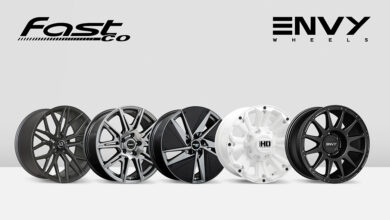Yokohama Tire Executives Reflect on Trends, Tire Market

Jeff Barna, president and CEO of Yokohama Tire, and Stan Chandgie, executive vice president of sales, recently reviewed 2021 and offered their thoughts on what to expect in 2022 in a Q&A. The interview has been edited for length.
Question: The pandemic caused a variety of industry challenges, from inventory control to R&D to product launches and so on. How did Yokohama successfully deal with them? Do you think issues such as the supply chain slowdown will be resolved in 2022? When do you see things returning to normal?
Jeff Barna: We met or exceeded expectations from a product launch and R&D perspective in ’21. In respect to the latter, we continue to invest in personnel, technology and equipment at our tech center in Charlotte to de-emphasize our reliance on Japan’s R&D’s capabilities. This should, as you might imagine, foster speed of development, help drive existing product improvements (upgrades) while also building out new OE capability for North American OEMs.
In respect to our industry’s supply chain dilemma, I believe those projecting a return to normalcy in 2022 might be a bit too optimistic. To understand the true depth of this breakdown, one would need to peel back the dozen or so layers that have contributed to the malaise. As an example, knowing that we have a problem with the 85-plus steamships anchored off the Port of Long Beach is only the tip of the ‘macro’ iceberg.
Understanding the micro factors building up to this backlog would require a deep analysis (and recovery projections) of microchip shortages, plant shutdowns, labor unrest at the ports, driver shortages, excess container complications, potential freight company arbitrage, market supply/demand and more. The point here being that even if some or most of these are remedied in the near future, it will likely be 2023 before re-alignment of all variables is achieved.
Question: Which segment was affected most by the pandemic: the consumer tire market or commercial? Why? Which market has recovered faster?
Stan Chandgie: We saw less disruption in the commercial market at the onset of the pandemic than we did on the consumer side, simply due to the initial drop in consumer demand, as stay-at-home mandates and travel restrictions were enforced around the country.
However, as COVID restrictions relaxed, we saw a rapid increase in miles driven, as pent-up travelers quickly took to the road again. The increase in demand was definitely a positive sign for all, but it also created a new set of downstream challenges as the industry quickly tried to recover from pandemic related shutdowns, labor shortages and supply chain bottlenecks.
Despite these challenges, Yokohama remained proactive in the market and transparent with our channel partners to anticipate and solve any issue we might face. I believe this approach helped us strengthen our existing partnerships and was the key factor in growing both our commercial and consumer tire business well beyond pre-pandemic levels.
Question: How did the consumer and commercial tire segments do in 2021?
Chandgie: Both segments were able to exceed the 2021 plan, and outperformed 2019 sales results (as a fair, full-year comparison). Additionally, consumer replacement continually outpaced the market in 2021, resulting in solid market share gains throughout the year.
Question: What’s the outlook for Yokohama in 2022?
Barna: We believe that demand will once again outstrip supply, so we anticipate no changes on the importance of working even closer with our channel partners on demand planning and forecasting. Overall, ’22 is shaping up to be another solid growth year for us, but maintaining our focus on resilience and agility is paramount.
Question: What’s the outlook for both markets in 2022?
Chandgie: Similar to 2021, we anticipate demand will stay strong and supply to remain challenged for both the commercial and consumer markets. Our focus will continue to be on supporting our teams and aligning with our channel partners, in order to put ourselves in the best position to grow in 2022 and beyond.
Question: What new trends do you see in the tire industry in 2022?
Barna: To me, trends by definition relate to activities and behaviors (and their corresponding investments) resulting in a change of trajectory. To that end, I do not see anything remarkable that will arise in ’22 that has not already been contemplated in the past. In respect to ongoing business changes worth watching, I’d say the movement toward further manufacturer environmental stewardship (carbon neutrality), the need for heightened tire industry governance on legislation and tire particulates, and the phenomena of supporting the emphasis of ‘last-mile’ products and services are of keen interest.
The final piece here is also tying to the EV fleet transformation moving forward. Oh, and consolidation – there seems to be an inordinate amount of M&A activity in this market, but again, not a new trend.
Question: Is Yokohama exploring any new markets?
Barna: Yes, we are actively defining our EV agenda while scoping both our design and manufacturing capabilities for the future. Of course, this is a pretty monumental undertaking because of the need to stay in the moment (serving all current market needs) while simultaneously trying to predict future legislation mandates, OEM production priorities, plus consumer preferences for the foreseeable future. We are also planning our launch into the van tire segment which is an excellent segue into addressing our last-mile delivery logistics strategy. This as well dovetails into the future of our EV strategy.
Question: What new trends do you see in the consumer & commercial tire markets in 2022? What new products does Yokohama have in the pipeline?
Chandgie: We likely will see a greater emphasis on existing trends in both markets, rather than ‘new’ emerging trends in 2022. Commercial fleet operators will continue to place a premium on tires that deliver the lowest TCO, while exploring integrated digital solutions (i.e., sensors), to actively monitor their fleet’s performance. Additionally, demand will continue to increase for light-truck commercial tires, as the rapid expansion of eCommerce and final-mile delivery services endures.
We have several new products on the horizon with one focus area being 19.5-inch and 17.5-inch offerings. This will allow us to take better advantage of the previously mentioned changes in the movement of freight.
On the consumer side, the shift from traditional passenger tire sizes to utility vehicle and light truck tire sizes will continue, with an increasing popularity in larger rim sizes ranging from 19 to 22 inches. Additionally, the increase in electric vehicles sales and shift in consumer preferences toward safer, more comfortable and longer-lasting tires will continue to shape replacement tire demand over the years to come.
Jeff mentioned a few of our strategic product initiatives, namely the van tire, but we remain steadfast in our commitment to continue to bring high value-added products to market. To that end, you can expect a few new highly anticipated UHP products to be added to our lineup in 2022. Collectively, we believe we are a product-first company, so you’ll see more replacements, as well as incremental offerings in the years to come.



